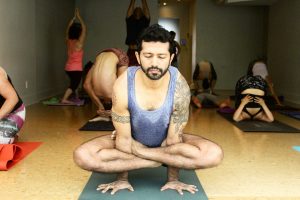Dristi is important in our Asana practice. It is one of the three Tristhanas or, “points of focus” during our practice along with Asana and Pranayama.
It’s probably the one apect of Tristhana I have the hardest time with. My eyes love to wander around the room occasionally. I like to check out what other people are doing. Especially if Jelena or David is in the room doing some crazy asana. Or if a friend of mine is working on a pose that’s challenging for them, I kinda want to see how it goes.
I know. I’m a bad lady.
But I bet you can relate?!
Dristi is important for so many reasons, and I know it’s the first point of focus to go when I become distracted. In fact, when my gaze shifts around the room, I find myself slowly but surely unraveling my other points of focus. It’s like a domino effect.
But I also know that when I’m really disciplined and paying close attention to my gaze, my practice feels much deeper. I can more easily tap into my breath and navigate the various asanas.
Dristi, I’ve realized for me at least, is foundational, and instrumental to my level focus and concentration throughout my practice.
So this week, I thought I’d discuss why it’s so important to our practice.

4 Reasons why Dristi is Important:
1. Dristi improves balance
Keeping your gaze steady helps to maintain balance in those especially challenging poses. Our eyes are a huge sensory organ that can help support and calm the nervous system, which in turn helps with balance. When our gaze is strong, steady and focused, our balance follows suit.
2. Maintaining steady Dristi develops concentration
Those practices when I’m completely concentrated on tristhana – Pranayama, Asana and Dristi, I feel like I am a laser-focused, Ashtanga rock star. Funny enough, the thing that always slips first, is to focus on my Dristi. The temptation to look around the room at what other people are doing is VERY enticing and almost always creates a domino effect of me not focusing on my breath… and then slowly paying less attention to my asana. Being diligent and disciplined about Dristi is a great way to develop and improve concentration during your practice.
3. The correct Dristi reinforces alignment in each Asana:
In Ashtanga we have a Dristi for every pose, so we don’t even have to think about it. But each Dristi actually reinforces the alignment of that posture. Take downward dog for example. Nābhou or Naval Dristi, reinforces the alignment of the neck and the spine in this Asana. In Warrior 2, Hastagrahe Dristi reinforces the position of the head. When we look in each posture, we can see how each unique Dristi plays an important role in the correct alignment and condition of the asana.
4. Maintaining Dristi stops you from seeing other peoples junk
Junk? You mean other peoples junky Asana? Nope. I mean their JUNK. Their private parts.
With the rise of small yoga shorts, the incidence of junk exposure has increased by 23.5% amongst Ashtangis. Specifically it has increased by 83% in Upavista Konasana.
That’s obviously a made-up statistic but probably isn’t untrue!
But here is a TRUE statistic: When you are maintaining the correct Dristi you have a 0% chance of accidentally peeping someones… eh-em, secret bits. If the first three reason’s for keeping your Dristi weren’t enough, this one absolutely is.

Keep your eyes on the prize fellow Ashtangis, and maintain the correct Dristi!
In his book, Astanga Yoga Anusthana, Sharath mentions each of the Dristi’s for each posture. Learn them. Memorize them. Practice them, and you will ever accidentally peep another persons junk again!
You can grab his book at our Shala, or on Amazon. You could also just come to the Shala, and practice with our amazing teachers who will show you the way!
Do you struggle with Dristi? Do you make a conscious effort to ensure you’re using the correct Dristi in each Asana? Let us know in the comments below!
Happy Gazing!
